Comprehensive Report: Australian Dollar and Exchange Rate Dynamics
VerifiedAdded on 2021/05/31
|33
|5865
|40
Report
AI Summary
This report provides a comprehensive analysis of the Australian Dollar (AUD) and its exchange rates. It begins by identifying key factors influencing AUD movements, including farming, Reserve Bank policies, and mining, and discusses their effects on the Australian economy. The report then examines how exchange rate fluctuations impact Australian businesses, differentiating between the effects of appreciation and depreciation. It further explores foreign exchange hedging strategies. The report delves into the roles of interest rates in the economy, including their influence on price levels, economic growth, and unemployment. It also compares expansionary and contractionary monetary policies. The report then examines fiscal policy, the impact of unemployment measures, and the potential effects of a Goods and Services Tax (GST) increase. Finally, it analyzes the Bank of England's interest rate decisions and the UK's economic indicators, using graphs to illustrate relationships between variables. The report provides a detailed overview of how various economic factors interact and affect currency values and business outcomes.
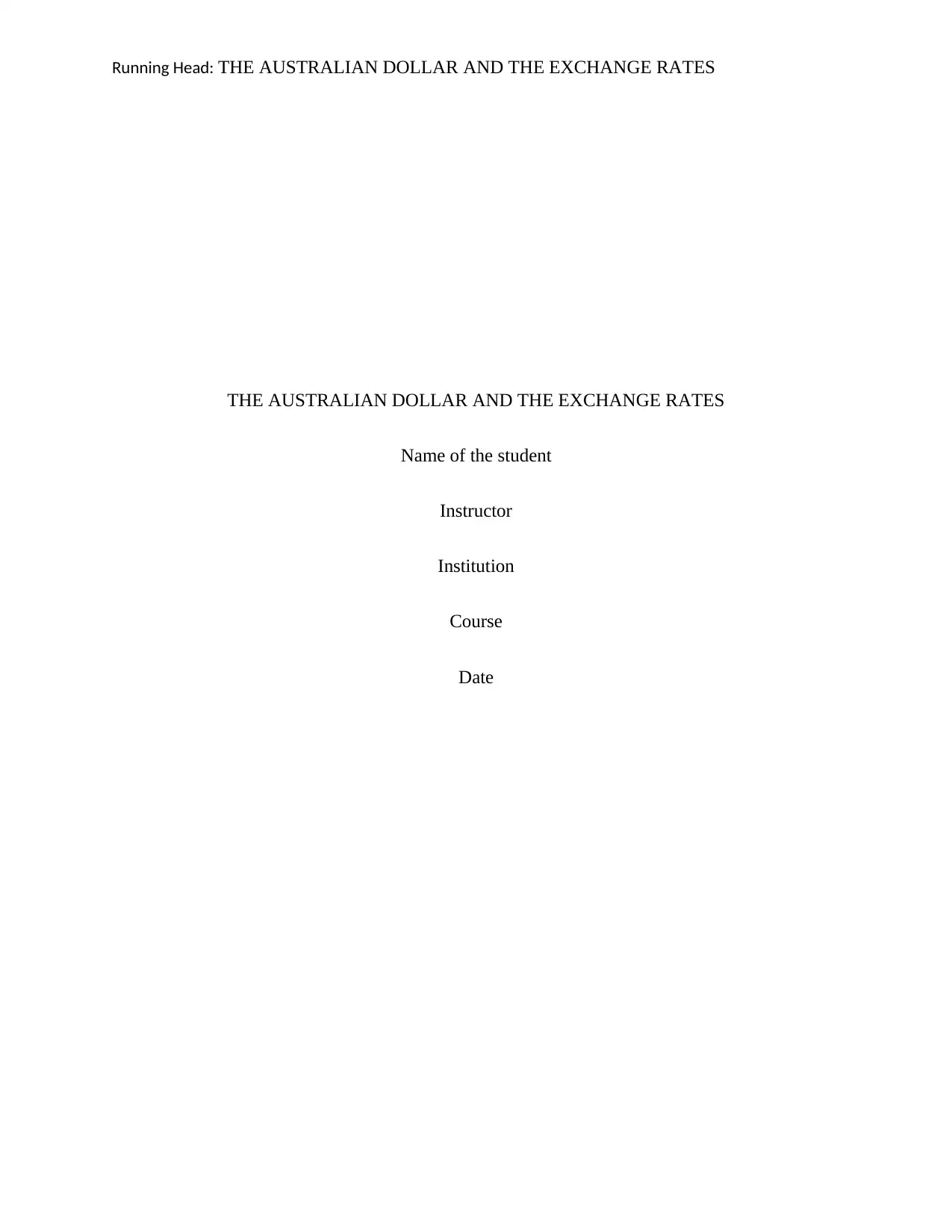
Running Head: THE AUSTRALIAN DOLLAR AND THE EXCHANGE RATES
THE AUSTRALIAN DOLLAR AND THE EXCHANGE RATES
Name of the student
Instructor
Institution
Course
Date
THE AUSTRALIAN DOLLAR AND THE EXCHANGE RATES
Name of the student
Instructor
Institution
Course
Date
Paraphrase This Document
Need a fresh take? Get an instant paraphrase of this document with our AI Paraphraser
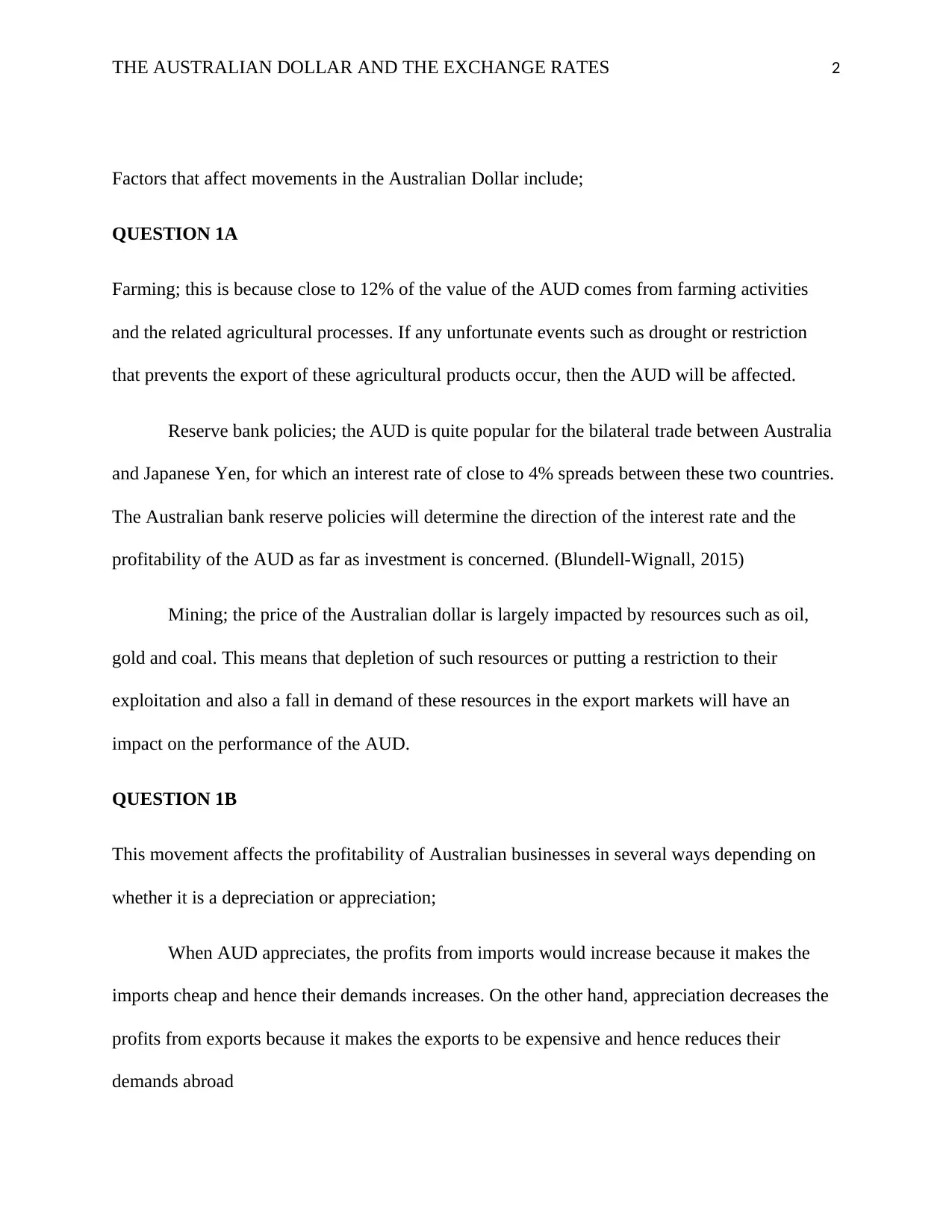
THE AUSTRALIAN DOLLAR AND THE EXCHANGE RATES 2
Factors that affect movements in the Australian Dollar include;
QUESTION 1A
Farming; this is because close to 12% of the value of the AUD comes from farming activities
and the related agricultural processes. If any unfortunate events such as drought or restriction
that prevents the export of these agricultural products occur, then the AUD will be affected.
Reserve bank policies; the AUD is quite popular for the bilateral trade between Australia
and Japanese Yen, for which an interest rate of close to 4% spreads between these two countries.
The Australian bank reserve policies will determine the direction of the interest rate and the
profitability of the AUD as far as investment is concerned. (Blundell-Wignall, 2015)
Mining; the price of the Australian dollar is largely impacted by resources such as oil,
gold and coal. This means that depletion of such resources or putting a restriction to their
exploitation and also a fall in demand of these resources in the export markets will have an
impact on the performance of the AUD.
QUESTION 1B
This movement affects the profitability of Australian businesses in several ways depending on
whether it is a depreciation or appreciation;
When AUD appreciates, the profits from imports would increase because it makes the
imports cheap and hence their demands increases. On the other hand, appreciation decreases the
profits from exports because it makes the exports to be expensive and hence reduces their
demands abroad
Factors that affect movements in the Australian Dollar include;
QUESTION 1A
Farming; this is because close to 12% of the value of the AUD comes from farming activities
and the related agricultural processes. If any unfortunate events such as drought or restriction
that prevents the export of these agricultural products occur, then the AUD will be affected.
Reserve bank policies; the AUD is quite popular for the bilateral trade between Australia
and Japanese Yen, for which an interest rate of close to 4% spreads between these two countries.
The Australian bank reserve policies will determine the direction of the interest rate and the
profitability of the AUD as far as investment is concerned. (Blundell-Wignall, 2015)
Mining; the price of the Australian dollar is largely impacted by resources such as oil,
gold and coal. This means that depletion of such resources or putting a restriction to their
exploitation and also a fall in demand of these resources in the export markets will have an
impact on the performance of the AUD.
QUESTION 1B
This movement affects the profitability of Australian businesses in several ways depending on
whether it is a depreciation or appreciation;
When AUD appreciates, the profits from imports would increase because it makes the
imports cheap and hence their demands increases. On the other hand, appreciation decreases the
profits from exports because it makes the exports to be expensive and hence reduces their
demands abroad
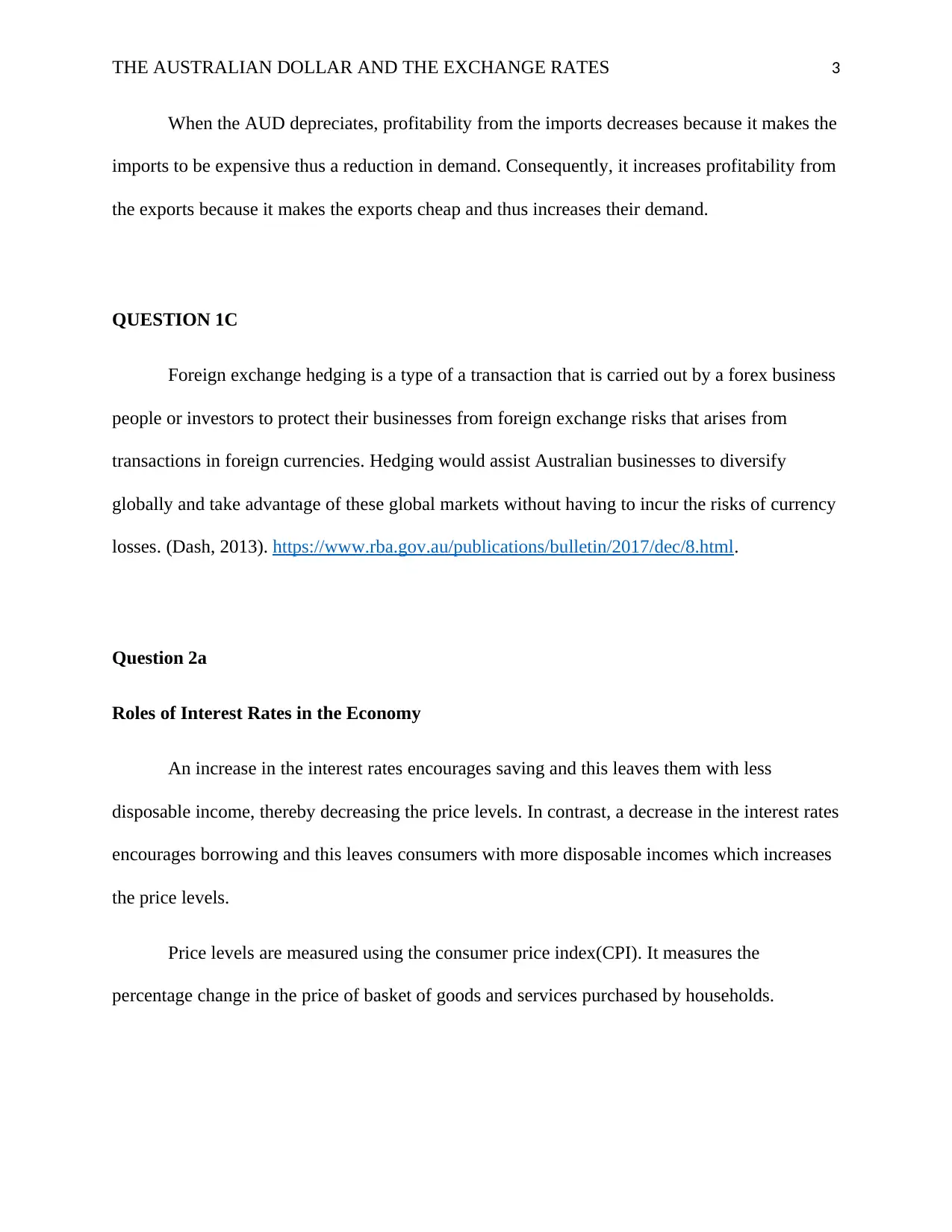
THE AUSTRALIAN DOLLAR AND THE EXCHANGE RATES 3
When the AUD depreciates, profitability from the imports decreases because it makes the
imports to be expensive thus a reduction in demand. Consequently, it increases profitability from
the exports because it makes the exports cheap and thus increases their demand.
QUESTION 1C
Foreign exchange hedging is a type of a transaction that is carried out by a forex business
people or investors to protect their businesses from foreign exchange risks that arises from
transactions in foreign currencies. Hedging would assist Australian businesses to diversify
globally and take advantage of these global markets without having to incur the risks of currency
losses. (Dash, 2013). https://www.rba.gov.au/publications/bulletin/2017/dec/8.html.
Question 2a
Roles of Interest Rates in the Economy
An increase in the interest rates encourages saving and this leaves them with less
disposable income, thereby decreasing the price levels. In contrast, a decrease in the interest rates
encourages borrowing and this leaves consumers with more disposable incomes which increases
the price levels.
Price levels are measured using the consumer price index(CPI). It measures the
percentage change in the price of basket of goods and services purchased by households.
When the AUD depreciates, profitability from the imports decreases because it makes the
imports to be expensive thus a reduction in demand. Consequently, it increases profitability from
the exports because it makes the exports cheap and thus increases their demand.
QUESTION 1C
Foreign exchange hedging is a type of a transaction that is carried out by a forex business
people or investors to protect their businesses from foreign exchange risks that arises from
transactions in foreign currencies. Hedging would assist Australian businesses to diversify
globally and take advantage of these global markets without having to incur the risks of currency
losses. (Dash, 2013). https://www.rba.gov.au/publications/bulletin/2017/dec/8.html.
Question 2a
Roles of Interest Rates in the Economy
An increase in the interest rates encourages saving and this leaves them with less
disposable income, thereby decreasing the price levels. In contrast, a decrease in the interest rates
encourages borrowing and this leaves consumers with more disposable incomes which increases
the price levels.
Price levels are measured using the consumer price index(CPI). It measures the
percentage change in the price of basket of goods and services purchased by households.
⊘ This is a preview!⊘
Do you want full access?
Subscribe today to unlock all pages.

Trusted by 1+ million students worldwide
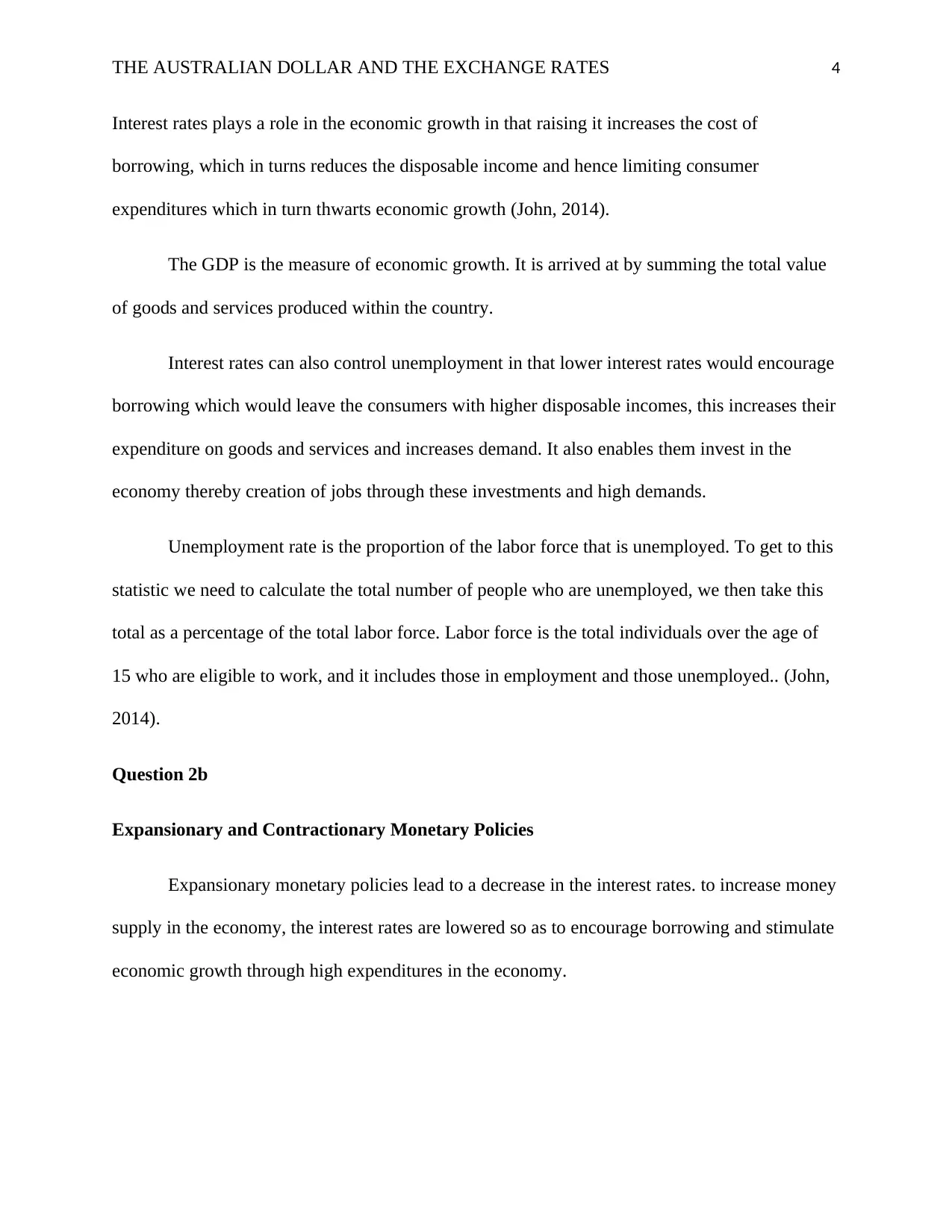
THE AUSTRALIAN DOLLAR AND THE EXCHANGE RATES 4
Interest rates plays a role in the economic growth in that raising it increases the cost of
borrowing, which in turns reduces the disposable income and hence limiting consumer
expenditures which in turn thwarts economic growth (John, 2014).
The GDP is the measure of economic growth. It is arrived at by summing the total value
of goods and services produced within the country.
Interest rates can also control unemployment in that lower interest rates would encourage
borrowing which would leave the consumers with higher disposable incomes, this increases their
expenditure on goods and services and increases demand. It also enables them invest in the
economy thereby creation of jobs through these investments and high demands.
Unemployment rate is the proportion of the labor force that is unemployed. To get to this
statistic we need to calculate the total number of people who are unemployed, we then take this
total as a percentage of the total labor force. Labor force is the total individuals over the age of
15 who are eligible to work, and it includes those in employment and those unemployed.. (John,
2014).
Question 2b
Expansionary and Contractionary Monetary Policies
Expansionary monetary policies lead to a decrease in the interest rates. to increase money
supply in the economy, the interest rates are lowered so as to encourage borrowing and stimulate
economic growth through high expenditures in the economy.
Interest rates plays a role in the economic growth in that raising it increases the cost of
borrowing, which in turns reduces the disposable income and hence limiting consumer
expenditures which in turn thwarts economic growth (John, 2014).
The GDP is the measure of economic growth. It is arrived at by summing the total value
of goods and services produced within the country.
Interest rates can also control unemployment in that lower interest rates would encourage
borrowing which would leave the consumers with higher disposable incomes, this increases their
expenditure on goods and services and increases demand. It also enables them invest in the
economy thereby creation of jobs through these investments and high demands.
Unemployment rate is the proportion of the labor force that is unemployed. To get to this
statistic we need to calculate the total number of people who are unemployed, we then take this
total as a percentage of the total labor force. Labor force is the total individuals over the age of
15 who are eligible to work, and it includes those in employment and those unemployed.. (John,
2014).
Question 2b
Expansionary and Contractionary Monetary Policies
Expansionary monetary policies lead to a decrease in the interest rates. to increase money
supply in the economy, the interest rates are lowered so as to encourage borrowing and stimulate
economic growth through high expenditures in the economy.
Paraphrase This Document
Need a fresh take? Get an instant paraphrase of this document with our AI Paraphraser
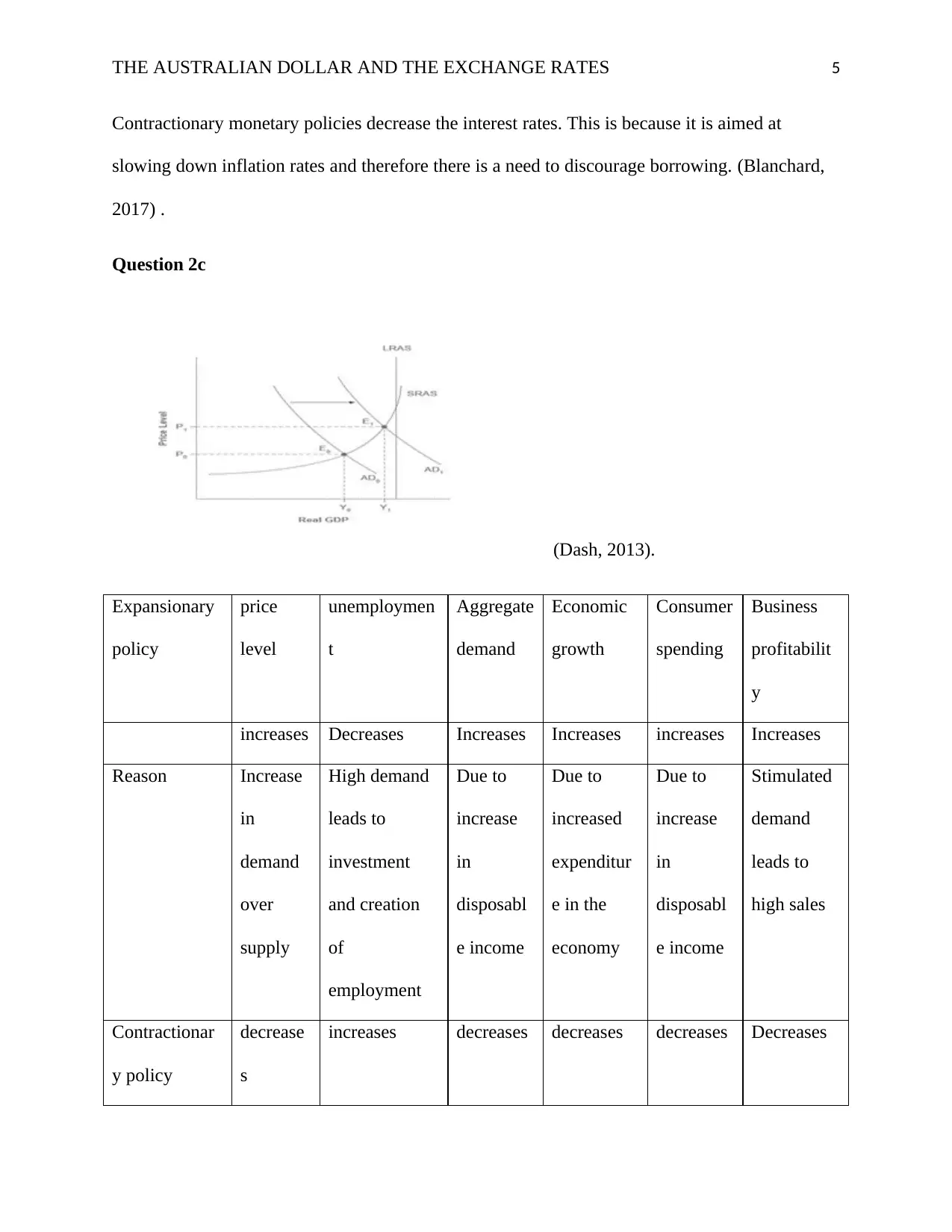
THE AUSTRALIAN DOLLAR AND THE EXCHANGE RATES 5
Contractionary monetary policies decrease the interest rates. This is because it is aimed at
slowing down inflation rates and therefore there is a need to discourage borrowing. (Blanchard,
2017) .
Question 2c
(Dash, 2013).
Expansionary
policy
price
level
unemploymen
t
Aggregate
demand
Economic
growth
Consumer
spending
Business
profitabilit
y
increases Decreases Increases Increases increases Increases
Reason Increase
in
demand
over
supply
High demand
leads to
investment
and creation
of
employment
Due to
increase
in
disposabl
e income
Due to
increased
expenditur
e in the
economy
Due to
increase
in
disposabl
e income
Stimulated
demand
leads to
high sales
Contractionar
y policy
decrease
s
increases decreases decreases decreases Decreases
Contractionary monetary policies decrease the interest rates. This is because it is aimed at
slowing down inflation rates and therefore there is a need to discourage borrowing. (Blanchard,
2017) .
Question 2c
(Dash, 2013).
Expansionary
policy
price
level
unemploymen
t
Aggregate
demand
Economic
growth
Consumer
spending
Business
profitabilit
y
increases Decreases Increases Increases increases Increases
Reason Increase
in
demand
over
supply
High demand
leads to
investment
and creation
of
employment
Due to
increase
in
disposabl
e income
Due to
increased
expenditur
e in the
economy
Due to
increase
in
disposabl
e income
Stimulated
demand
leads to
high sales
Contractionar
y policy
decrease
s
increases decreases decreases decreases Decreases
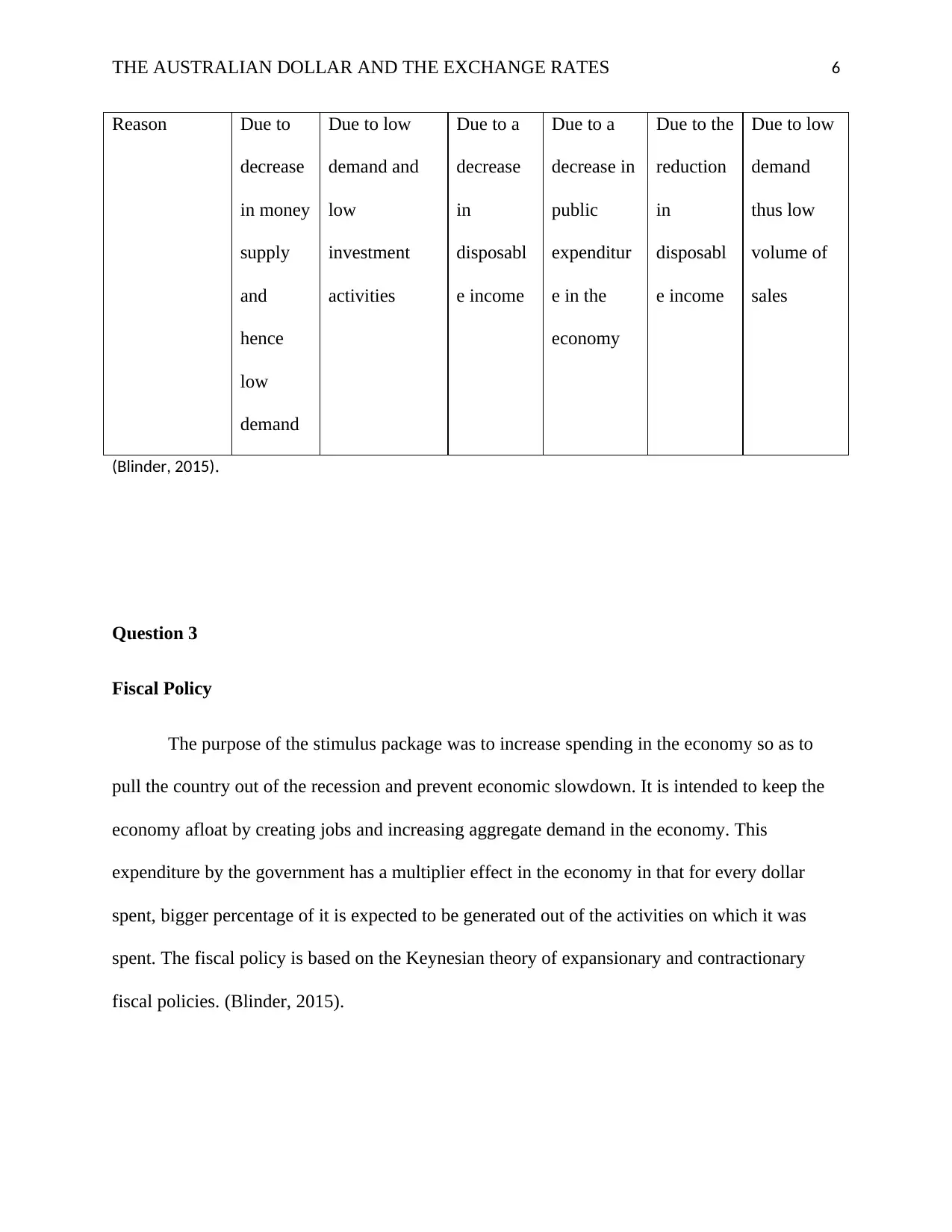
THE AUSTRALIAN DOLLAR AND THE EXCHANGE RATES 6
Reason Due to
decrease
in money
supply
and
hence
low
demand
Due to low
demand and
low
investment
activities
Due to a
decrease
in
disposabl
e income
Due to a
decrease in
public
expenditur
e in the
economy
Due to the
reduction
in
disposabl
e income
Due to low
demand
thus low
volume of
sales
(Blinder, 2015).
Question 3
Fiscal Policy
The purpose of the stimulus package was to increase spending in the economy so as to
pull the country out of the recession and prevent economic slowdown. It is intended to keep the
economy afloat by creating jobs and increasing aggregate demand in the economy. This
expenditure by the government has a multiplier effect in the economy in that for every dollar
spent, bigger percentage of it is expected to be generated out of the activities on which it was
spent. The fiscal policy is based on the Keynesian theory of expansionary and contractionary
fiscal policies. (Blinder, 2015).
Reason Due to
decrease
in money
supply
and
hence
low
demand
Due to low
demand and
low
investment
activities
Due to a
decrease
in
disposabl
e income
Due to a
decrease in
public
expenditur
e in the
economy
Due to the
reduction
in
disposabl
e income
Due to low
demand
thus low
volume of
sales
(Blinder, 2015).
Question 3
Fiscal Policy
The purpose of the stimulus package was to increase spending in the economy so as to
pull the country out of the recession and prevent economic slowdown. It is intended to keep the
economy afloat by creating jobs and increasing aggregate demand in the economy. This
expenditure by the government has a multiplier effect in the economy in that for every dollar
spent, bigger percentage of it is expected to be generated out of the activities on which it was
spent. The fiscal policy is based on the Keynesian theory of expansionary and contractionary
fiscal policies. (Blinder, 2015).
⊘ This is a preview!⊘
Do you want full access?
Subscribe today to unlock all pages.

Trusted by 1+ million students worldwide
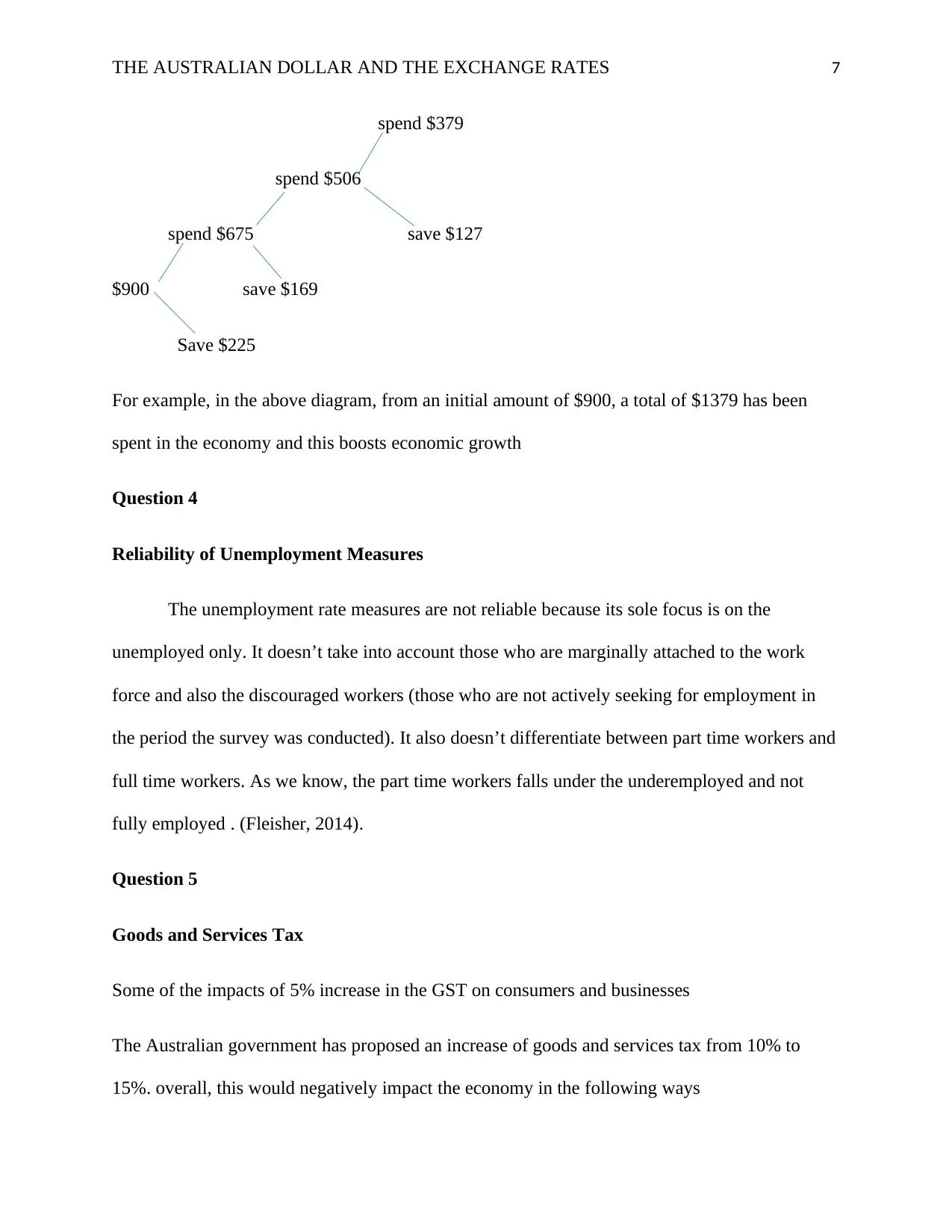
THE AUSTRALIAN DOLLAR AND THE EXCHANGE RATES 7
spend $379
spend $506
spend $675 save $127
$900 save $169
Save $225
For example, in the above diagram, from an initial amount of $900, a total of $1379 has been
spent in the economy and this boosts economic growth
Question 4
Reliability of Unemployment Measures
The unemployment rate measures are not reliable because its sole focus is on the
unemployed only. It doesn’t take into account those who are marginally attached to the work
force and also the discouraged workers (those who are not actively seeking for employment in
the period the survey was conducted). It also doesn’t differentiate between part time workers and
full time workers. As we know, the part time workers falls under the underemployed and not
fully employed . (Fleisher, 2014).
Question 5
Goods and Services Tax
Some of the impacts of 5% increase in the GST on consumers and businesses
The Australian government has proposed an increase of goods and services tax from 10% to
15%. overall, this would negatively impact the economy in the following ways
spend $379
spend $506
spend $675 save $127
$900 save $169
Save $225
For example, in the above diagram, from an initial amount of $900, a total of $1379 has been
spent in the economy and this boosts economic growth
Question 4
Reliability of Unemployment Measures
The unemployment rate measures are not reliable because its sole focus is on the
unemployed only. It doesn’t take into account those who are marginally attached to the work
force and also the discouraged workers (those who are not actively seeking for employment in
the period the survey was conducted). It also doesn’t differentiate between part time workers and
full time workers. As we know, the part time workers falls under the underemployed and not
fully employed . (Fleisher, 2014).
Question 5
Goods and Services Tax
Some of the impacts of 5% increase in the GST on consumers and businesses
The Australian government has proposed an increase of goods and services tax from 10% to
15%. overall, this would negatively impact the economy in the following ways
Paraphrase This Document
Need a fresh take? Get an instant paraphrase of this document with our AI Paraphraser
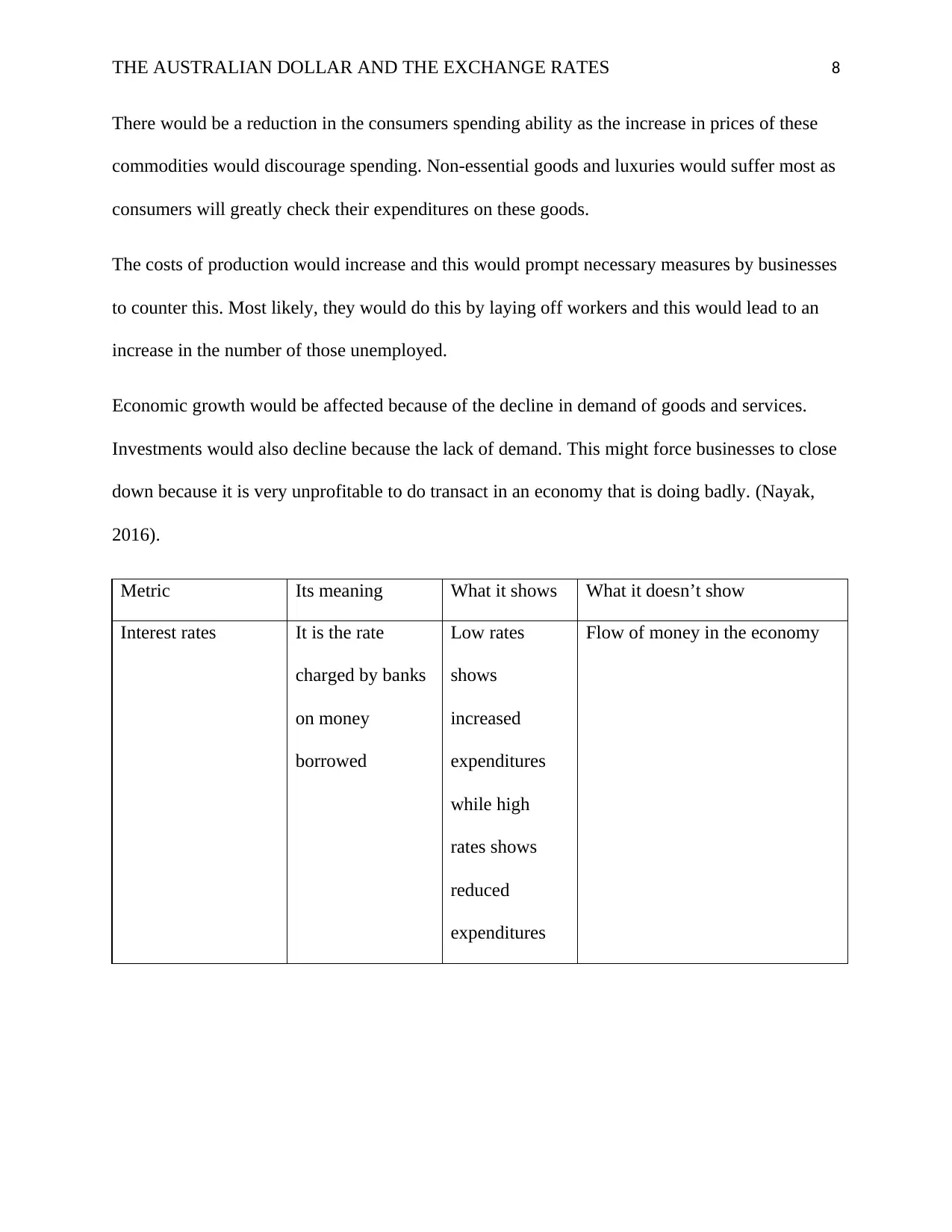
THE AUSTRALIAN DOLLAR AND THE EXCHANGE RATES 8
There would be a reduction in the consumers spending ability as the increase in prices of these
commodities would discourage spending. Non-essential goods and luxuries would suffer most as
consumers will greatly check their expenditures on these goods.
The costs of production would increase and this would prompt necessary measures by businesses
to counter this. Most likely, they would do this by laying off workers and this would lead to an
increase in the number of those unemployed.
Economic growth would be affected because of the decline in demand of goods and services.
Investments would also decline because the lack of demand. This might force businesses to close
down because it is very unprofitable to do transact in an economy that is doing badly. (Nayak,
2016).
Metric Its meaning What it shows What it doesn’t show
Interest rates It is the rate
charged by banks
on money
borrowed
Low rates
shows
increased
expenditures
while high
rates shows
reduced
expenditures
Flow of money in the economy
There would be a reduction in the consumers spending ability as the increase in prices of these
commodities would discourage spending. Non-essential goods and luxuries would suffer most as
consumers will greatly check their expenditures on these goods.
The costs of production would increase and this would prompt necessary measures by businesses
to counter this. Most likely, they would do this by laying off workers and this would lead to an
increase in the number of those unemployed.
Economic growth would be affected because of the decline in demand of goods and services.
Investments would also decline because the lack of demand. This might force businesses to close
down because it is very unprofitable to do transact in an economy that is doing badly. (Nayak,
2016).
Metric Its meaning What it shows What it doesn’t show
Interest rates It is the rate
charged by banks
on money
borrowed
Low rates
shows
increased
expenditures
while high
rates shows
reduced
expenditures
Flow of money in the economy
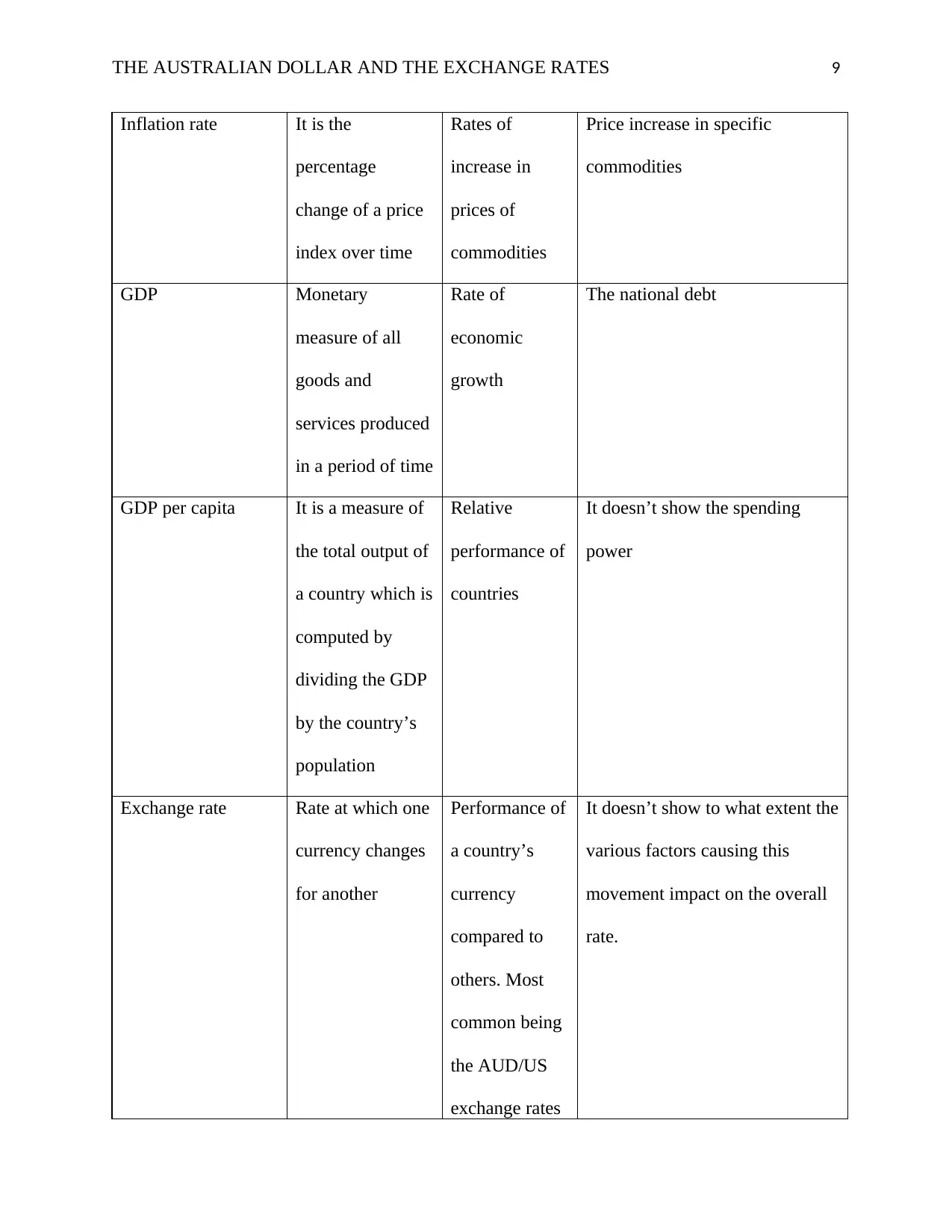
THE AUSTRALIAN DOLLAR AND THE EXCHANGE RATES 9
Inflation rate It is the
percentage
change of a price
index over time
Rates of
increase in
prices of
commodities
Price increase in specific
commodities
GDP Monetary
measure of all
goods and
services produced
in a period of time
Rate of
economic
growth
The national debt
GDP per capita It is a measure of
the total output of
a country which is
computed by
dividing the GDP
by the country’s
population
Relative
performance of
countries
It doesn’t show the spending
power
Exchange rate Rate at which one
currency changes
for another
Performance of
a country’s
currency
compared to
others. Most
common being
the AUD/US
exchange rates
It doesn’t show to what extent the
various factors causing this
movement impact on the overall
rate.
Inflation rate It is the
percentage
change of a price
index over time
Rates of
increase in
prices of
commodities
Price increase in specific
commodities
GDP Monetary
measure of all
goods and
services produced
in a period of time
Rate of
economic
growth
The national debt
GDP per capita It is a measure of
the total output of
a country which is
computed by
dividing the GDP
by the country’s
population
Relative
performance of
countries
It doesn’t show the spending
power
Exchange rate Rate at which one
currency changes
for another
Performance of
a country’s
currency
compared to
others. Most
common being
the AUD/US
exchange rates
It doesn’t show to what extent the
various factors causing this
movement impact on the overall
rate.
⊘ This is a preview!⊘
Do you want full access?
Subscribe today to unlock all pages.

Trusted by 1+ million students worldwide
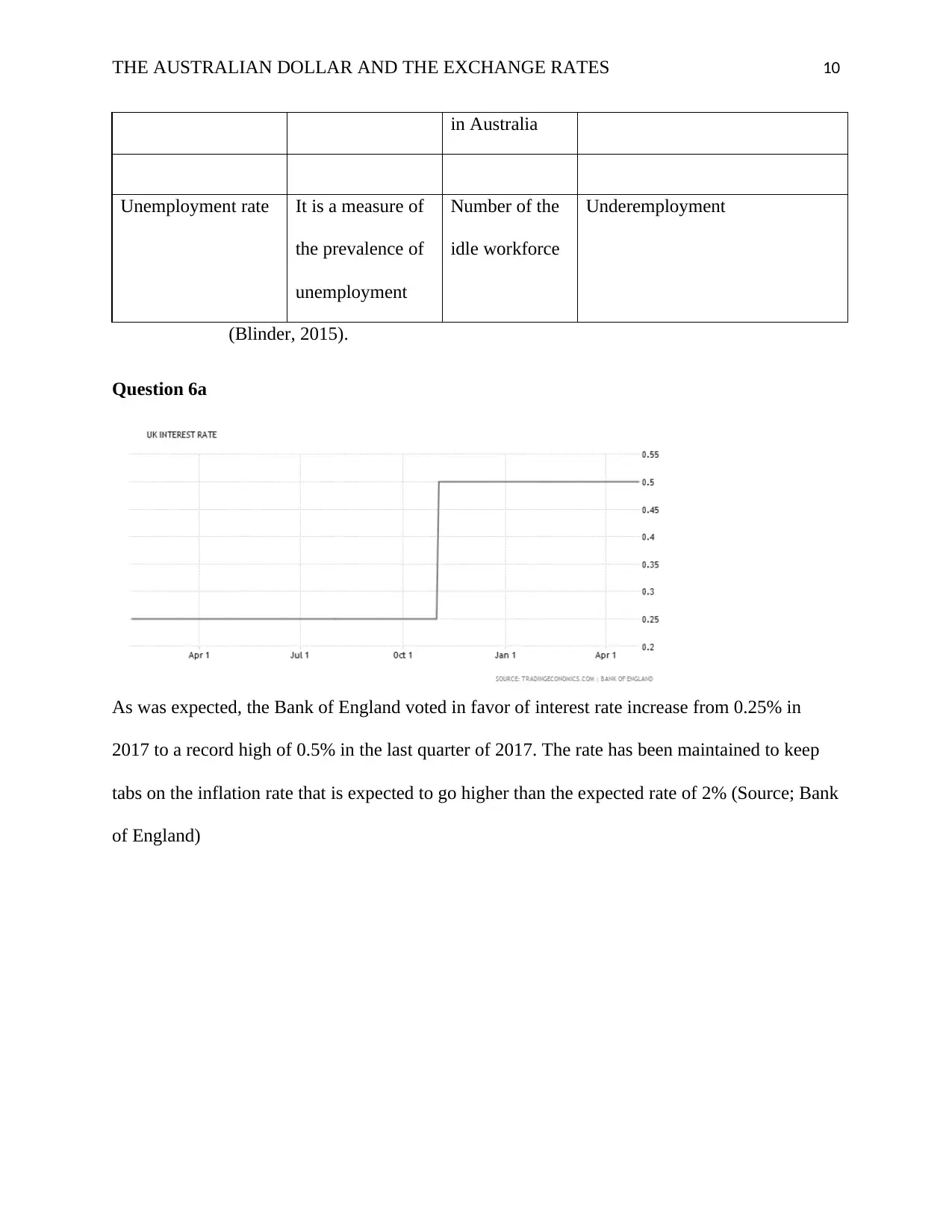
THE AUSTRALIAN DOLLAR AND THE EXCHANGE RATES 10
in Australia
Unemployment rate It is a measure of
the prevalence of
unemployment
Number of the
idle workforce
Underemployment
(Blinder, 2015).
Question 6a
As was expected, the Bank of England voted in favor of interest rate increase from 0.25% in
2017 to a record high of 0.5% in the last quarter of 2017. The rate has been maintained to keep
tabs on the inflation rate that is expected to go higher than the expected rate of 2% (Source; Bank
of England)
in Australia
Unemployment rate It is a measure of
the prevalence of
unemployment
Number of the
idle workforce
Underemployment
(Blinder, 2015).
Question 6a
As was expected, the Bank of England voted in favor of interest rate increase from 0.25% in
2017 to a record high of 0.5% in the last quarter of 2017. The rate has been maintained to keep
tabs on the inflation rate that is expected to go higher than the expected rate of 2% (Source; Bank
of England)
Paraphrase This Document
Need a fresh take? Get an instant paraphrase of this document with our AI Paraphraser
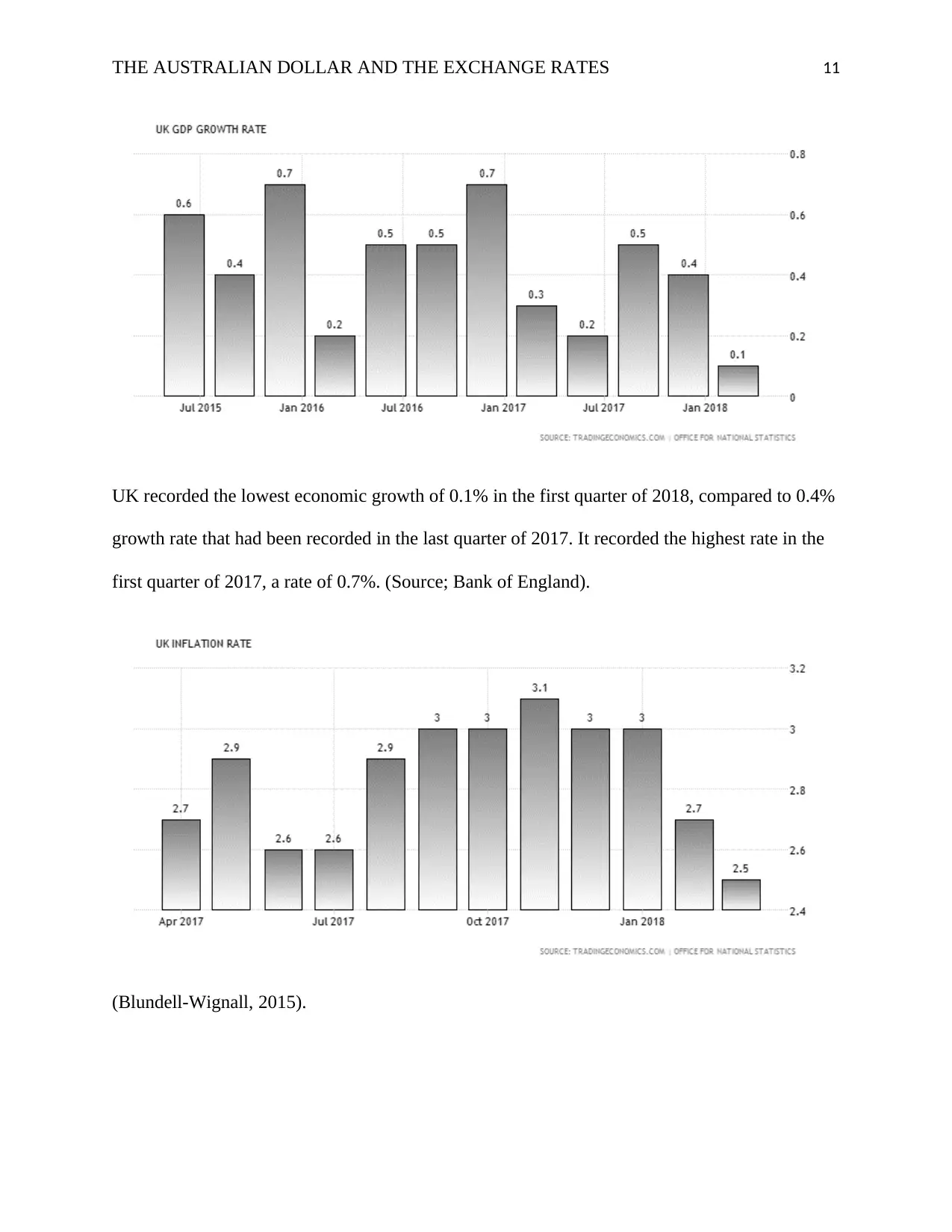
THE AUSTRALIAN DOLLAR AND THE EXCHANGE RATES 11
UK recorded the lowest economic growth of 0.1% in the first quarter of 2018, compared to 0.4%
growth rate that had been recorded in the last quarter of 2017. It recorded the highest rate in the
first quarter of 2017, a rate of 0.7%. (Source; Bank of England).
(Blundell-Wignall, 2015).
UK recorded the lowest economic growth of 0.1% in the first quarter of 2018, compared to 0.4%
growth rate that had been recorded in the last quarter of 2017. It recorded the highest rate in the
first quarter of 2017, a rate of 0.7%. (Source; Bank of England).
(Blundell-Wignall, 2015).
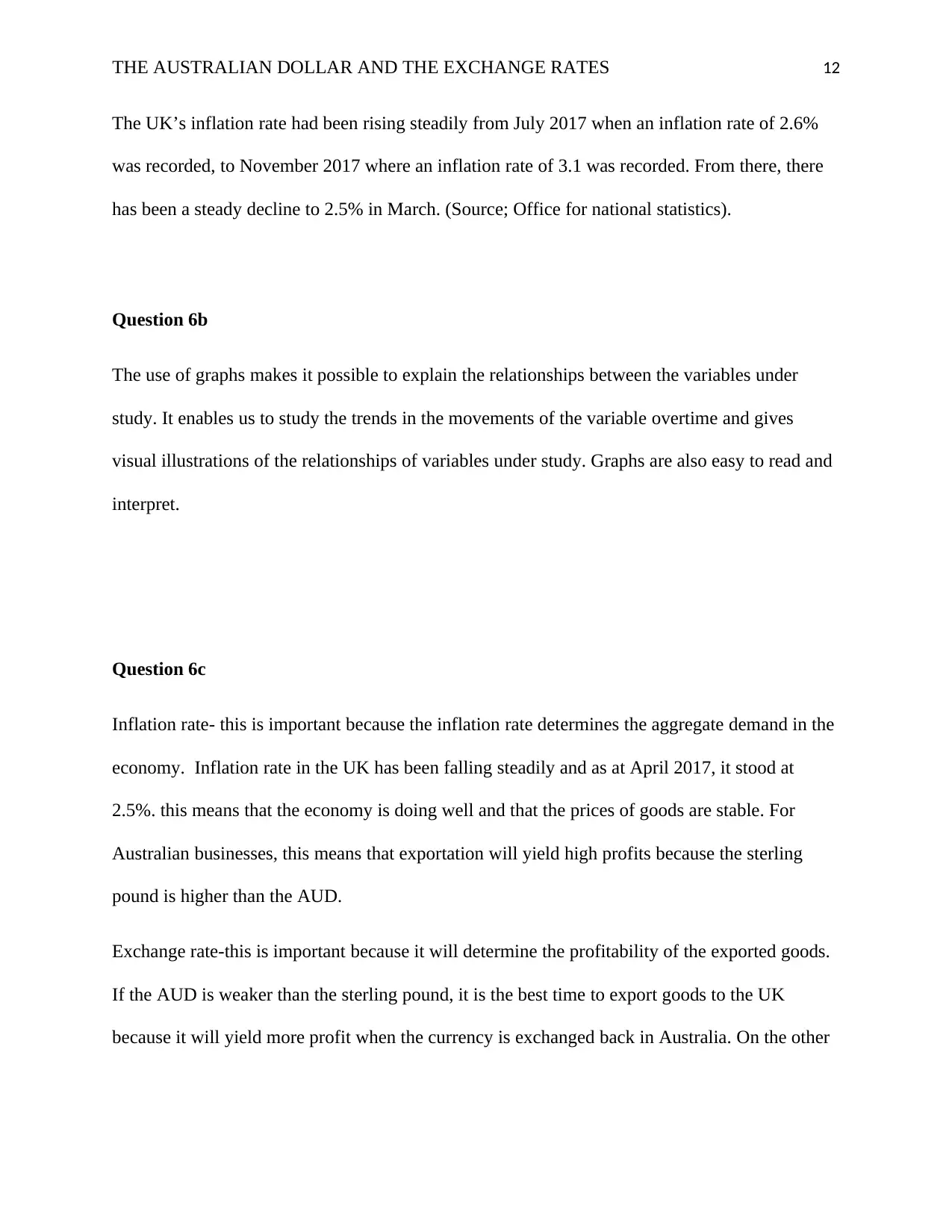
THE AUSTRALIAN DOLLAR AND THE EXCHANGE RATES 12
The UK’s inflation rate had been rising steadily from July 2017 when an inflation rate of 2.6%
was recorded, to November 2017 where an inflation rate of 3.1 was recorded. From there, there
has been a steady decline to 2.5% in March. (Source; Office for national statistics).
Question 6b
The use of graphs makes it possible to explain the relationships between the variables under
study. It enables us to study the trends in the movements of the variable overtime and gives
visual illustrations of the relationships of variables under study. Graphs are also easy to read and
interpret.
Question 6c
Inflation rate- this is important because the inflation rate determines the aggregate demand in the
economy. Inflation rate in the UK has been falling steadily and as at April 2017, it stood at
2.5%. this means that the economy is doing well and that the prices of goods are stable. For
Australian businesses, this means that exportation will yield high profits because the sterling
pound is higher than the AUD.
Exchange rate-this is important because it will determine the profitability of the exported goods.
If the AUD is weaker than the sterling pound, it is the best time to export goods to the UK
because it will yield more profit when the currency is exchanged back in Australia. On the other
The UK’s inflation rate had been rising steadily from July 2017 when an inflation rate of 2.6%
was recorded, to November 2017 where an inflation rate of 3.1 was recorded. From there, there
has been a steady decline to 2.5% in March. (Source; Office for national statistics).
Question 6b
The use of graphs makes it possible to explain the relationships between the variables under
study. It enables us to study the trends in the movements of the variable overtime and gives
visual illustrations of the relationships of variables under study. Graphs are also easy to read and
interpret.
Question 6c
Inflation rate- this is important because the inflation rate determines the aggregate demand in the
economy. Inflation rate in the UK has been falling steadily and as at April 2017, it stood at
2.5%. this means that the economy is doing well and that the prices of goods are stable. For
Australian businesses, this means that exportation will yield high profits because the sterling
pound is higher than the AUD.
Exchange rate-this is important because it will determine the profitability of the exported goods.
If the AUD is weaker than the sterling pound, it is the best time to export goods to the UK
because it will yield more profit when the currency is exchanged back in Australia. On the other
⊘ This is a preview!⊘
Do you want full access?
Subscribe today to unlock all pages.

Trusted by 1+ million students worldwide
1 out of 33
Related Documents
Your All-in-One AI-Powered Toolkit for Academic Success.
+13062052269
info@desklib.com
Available 24*7 on WhatsApp / Email
![[object Object]](/_next/static/media/star-bottom.7253800d.svg)
Unlock your academic potential
Copyright © 2020–2025 A2Z Services. All Rights Reserved. Developed and managed by ZUCOL.





